ARC-Grain Crops,
Agronomy,
Potchefstroom
 William Makgoga,
William Makgoga, ARC-Grain Crops,
Agronomy,
Potchefstroom
Sunflower (Helianthus annuus L.) is an annual oilseed crop globally cultivated on a production area of approximately 26 million ha that results in ± 47,4 million metric tons of seed annually – an 8% share of the world oilseed market. Sunflower oil is one of the world’s major vegetable oils, often used in the food industry for the production of various related commercial products due to its high quality, high protein content and edibility.
The average area under sunflower cultivation in South Africa since 2009 (up to 2021) is 552 000 ha, with an average annual production of 715 000 tons over this period. The South African sunflower production area remains concentrated in the Free State (FS) and North West (NW) provinces, which together account for 80% of the national area planted (on average) over the past ten years.
Sunflower and nitrogen
In sunflower production a nitrogen (N) fertiliser is often applied during seed sowing in dry areas. This is followed by another N fertiliser application, or topdressing, when precipitation is expected before anthesis, or until ten-leaf stage to twelve-leaf stage in an attempt to better match the plant’s N requirements over its growth period. Fertiliser application, depending on the expected yields and the residual soil N, varies in practice from none in nitrogen-rich soil to 140 kg N/ha. An N excess or over fertilisation can cause excessive water consumption, fungal diseases, lodging and a drop in grain oil content.
Several international studies reported that 100 kg N/ha was suitable for sunflower production, but that a higher rate (150 kg N/ha) resulted in a negative effect on the oil content and seed yield. However, other studies reported that 80 kg N/ha was sufficient for sunflower fertilisation or that increasing N levels resulted in steady increases in yield, protein contents and linoleic acid, with the oil content and oleic acid percentage responding negatively. Unfortunately, little or no research has been conducted in South Africa to quantify the optimum N application for local sunflower production conditions.
Sunflower planting dates
In South Africa, sunflower is often used as a catch crop, meaning it is planted as an alternative in growth seasons where the rainfall onset is too late for maize or soybean establishment. Therefore, the stable yields under these late planting conditions are well below the crop’s yield potential. Late sunflower plantings are more likely to encounter adverse conditions during their development, including seed or seedling exposure to high December or January temperatures, and pollination or seed development occurring under rapidly decreasing temperatures.
The optimum planting time of a crop allows maximising the use of all the natural resources in line with the crop optimal environmental conditions and physiological growth stages, thereby ensuring good seed germination, seedling establishment, optimum root system development, growth and yield. This also enables plants to establish themselves better, thereby allowing the absorption of essential nutrients from a large volume of soil. Sunflower grain and oil yields are greatly reduced when normal planting dates are delayed.
Trial description
This study aimed to address the effect of N fertilisation on sunflower yield under different planting dates. Two field experiments were established at ARC-Grain Crops’ Potchefstroom research farm with two different planting dates: The first planting was considered the optimum planting date (15 December 2020), followed by a second late planting date (26 January 2021). Five sunflower hybrids (two conventional [PAN 7080 and AGSUN 8251], two Clearfield [AGSUN 5106 CLP and PAN 7160 CLP] and one high oleic hybrid [PAN 7158 HO]) were planted.
Five different levels of N fertiliser were applied, consisting of 0 (control) or 45 kg/ha N as a basal application at planting or as a treatment one month prior to planting. This was followed with a topdressing one month from planting applied as 0 kg/ha, 45 kg/ha or 75 kg/ha (Table 1). According to soil analysis and sunflower production requirements, additional phosphate (P) and potassium (K) fertilisers were not required.

Responses were studied in a randomised complete block design with a split-plot arrangement and four replications. Each plot (36 m x 5 m) comprised 40 rows at 0,9 m as row spacing and with sub-plot sizes of 7,2 m x 5 m, with N applications in the main plots and sunflower hybrids in the sub-plots.
Effect of N on sunflower yield
The different N applications showed a highly significant effect on sunflower yield at both planting dates, with 120 kg N/ha – applied as 45 kg/ha at planting and 75 kg/ha as topdressing – producing the highest yields: 2,85 t/ha for the optimal and 2,14 t/ha for the late planting dates (Graph 1). This was followed by 90 kg N/ha applied as 45 kg/ha at planting and 45 kg/ha as topdressing. There were no significant differences between 45 kg/ha applied one month before planting and the 45 kg/ha applied at planting. Zero N application yielded the lowest yield of 1,85 t/ha and 1,35 t/ha for optimum and late planting respectively (Graph 1).
The graph shows the combined average of the different cultivars, thus removing possible cultivar biases, with the bar indicating the standard error over the four replicates (n = 4).
Figure 1 shows the effect of different N levels and time of application on the sunflower growth and development. At 120 kg and 90 kg N/ha the plants have bigger leaves, a darker green colour, thicker stems, a bigger head and are taller compared to other treatments. At 0 kg N/ha the plants show less vegetative growth, smaller leave size, shorter plant height and smaller head size than at other N levels. Results indicated that these vegetative characteristics have a direct positive effect on the sunflower seed yield.

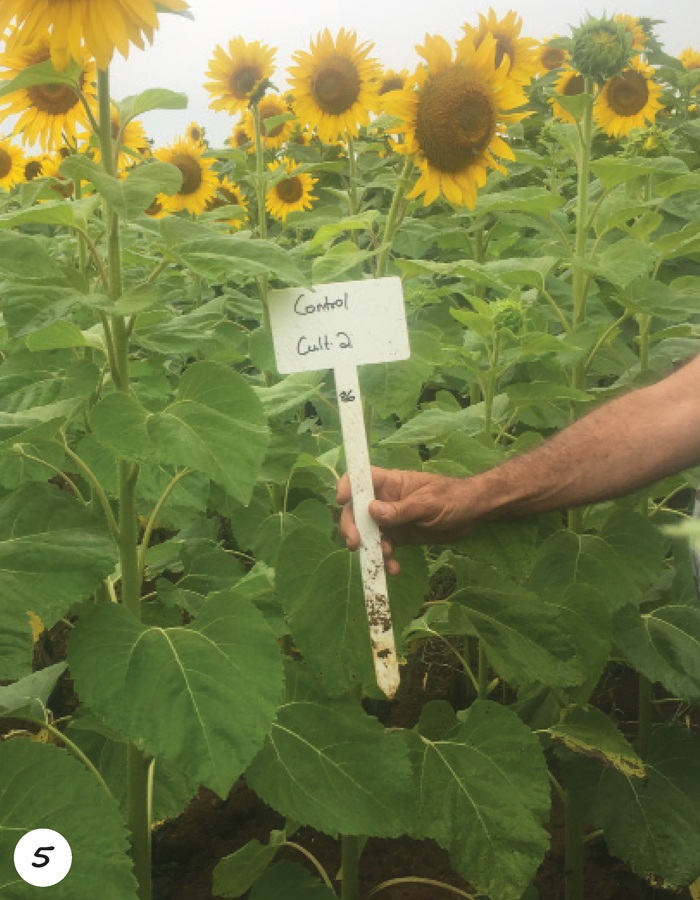
Indexes of N use efficiency
Agronomic efficiency (AE) represents the ability of a plant/cultivar to increase yield in response to the nutrient applied. This parameter is used as a short-term indicator of the impact of applied nutrients on crop productivity. Here, the AE is calculated in units of yield increase per unit of nutrient (N) applied. It more closely reflects the direct production impact of an applied fertiliser and relates directly to economic return. The calculation of AE requires knowledge of yield without nutrient input, so it is only known when research plots with zero nutrient input have been implemented.
Under the optimum planting date, the highest AE value (12,23 kg/kg) was obtained with the 45 kg N/ha treatment, while under late planting conditions the highest AE (8,58 kg/kg) was observed at 45 kg/ha applied one month before planting (Table 2). In other words, under the optimum planting date, for each kilogram N fertiliser applied, an increase of 12,23 kg in yield was observed.

The AE equation indicates the yield gain (in kg) per kg fertiliser applied (Mengel et al., 2006).
Best return on investment (ROI)
Correct use of fertilisers can yield huge returns on investment. During the 2021 growing season a one-year result at Potchefstroom research farm showed that the best ROI was obtained by using 45 kg N/ha, which is equal to 98 kg of urea compared to other N levels (Table 3).

Urea price: R8 000/ton
Sunflower seed price: R8 500/ton
Concluding remarks
Highly significant seed yield differences were observed between the optimum planting dates and the late plantings, with a 25% reduction in yield recorded for sunflower planted in the last week of January compared to the optimum planting date of mid-December. At both planting dates, high levels of N application (120 kg N/ha) recorded the highest yield with the zero N application control producing the least. However, nitrogen AE and best ROI indicated that an application of 45 kg N/ha at planting under optimum planting dates and one month before planting for late planting dates, showed the best yield increase per kilogram N fertiliser applied – the largest return for the least money spent.





























